As the one-year mark from Hurricane Sandy approaches, City Atlas continues our summaries of New York City’s comprehensive plan for the future — otherwise known as the Special Initiative for Rebuilding and Resiliency report (SIRR). We’ve boiled the 438 page original, published June 11, down to 60 pages, with an emphasis on the five community chapters, which show in practice how the initiatives in the SIRR would reshape the city towards greater resilience.
Our first installment covered the plan for the Brooklyn Queens Waterfront. What follows is a summary of the city’s report on Southern Brooklyn, including Coney Island.
The SIRR is a thirty year plan for a coastal community of eight million people; at present it is likely the most detailed climate change adaptation plan anywhere.
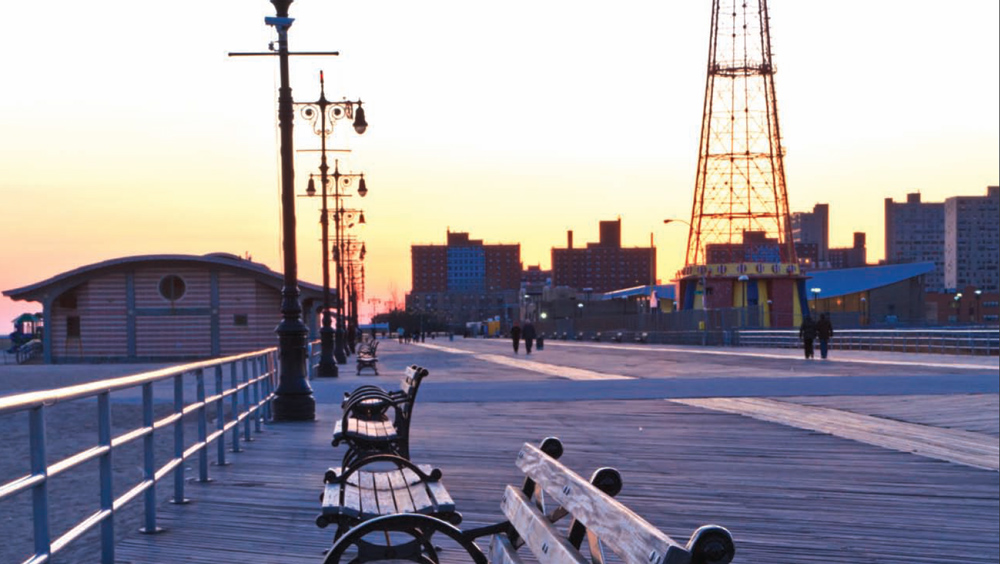
New Yorkers cherish Coney Island in multiple ways: as part of the history of the city, as a memory of playing Skee-ball as a kid or visiting the Aquarium, as the closest, most utilitarian beach for escaping midsummer heat, or in recent years, as a revitalized playground for offbeat culture. As a bustling community attached to the massive built environment of the city, it was easy to overlook how vulnerable Coney Island and the neighborhoods around it have always been to the full force of the Atlantic. The SIRR examines the existing conditions in Coney Island and several of the surrounding neighborhoods and considers how best to prepare for future extreme weather events.
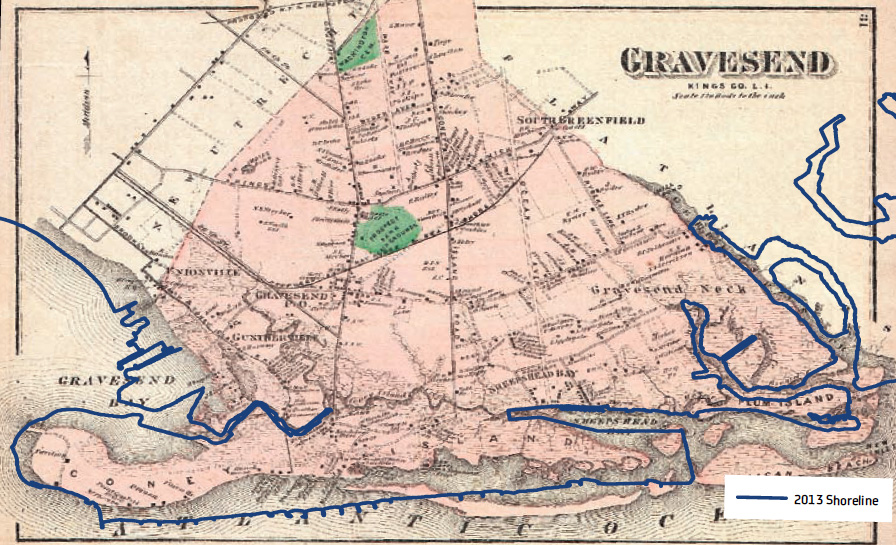
The neighborhood chapters of the SIRR each look back to the city’s original topography; here it is noted that at the time of European settlement, the South Brooklyn sea coast “was a collection of wetlands, tidal marshlands, bays, inlets, creeks, and barrier islands—first the fishing grounds of the Lenape people and then part of a quiet farming community.”
Coney Island was an island; the island only became attached to Brooklyn when property owners filled in Coney Island Creek. Because of its proximity to Manhattan as the city grew, the area first developed as a summer beach destination, but today, the communities are year-round neighborhoods. Brighton Beach, a landing spot for generations of Russian emigres, is adjacent to Coney Island.
The vast majority of the area’s residential buildings are private homes, but most of the households live in multi-family structures, including 37 public housing projects with 6,300 units. Although it varies between neighborhoods, the population density is close to the New York City average; about 190,000 people live in the coastal area of Southern Brooklyn, facing the Atlantic.
Although several large businesses—such as the Coney Island entertainment facilities—employ large sections of the population, the area primarily relies on small businesses on local commercial corridors. Important infrastructure in the region includes the MTA Coney Island Yards, which covers 75 acres, Coney Island Hospital, and the Coney Island Wastewater Treatment Plant. Because it was primarily developed in the 1920s, most of the building stock was constructed without the use of modern construction codes, and at very low elevations.
Socioeconomically, the region is fairly representative of New York City as a whole, with some neighborhoods more affluent than others. There are over 18,000 residents of NYCHA developments, including many individuals who have impaired mobility or are on life-support equipment.
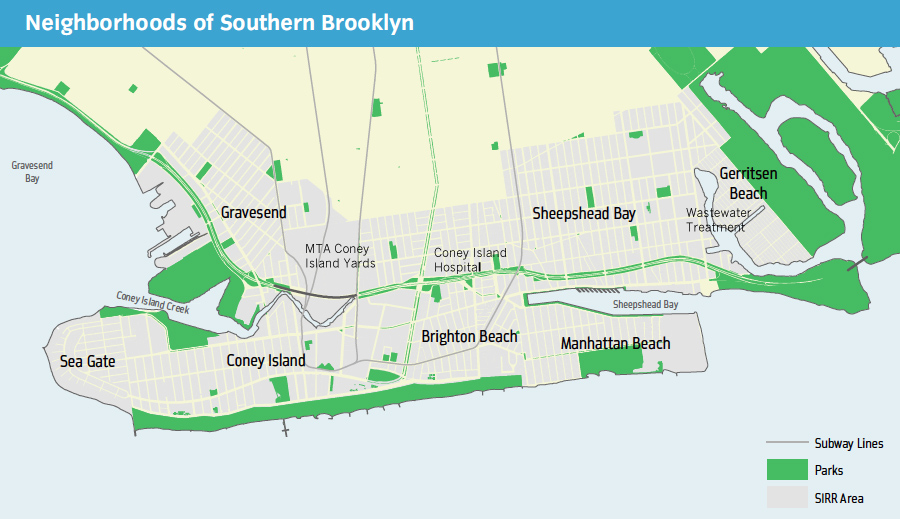
What Happened During and After Sandy & Future Risks:
Just as Southern Brooklyn’s beaches are some of the earliest and most heavily used urban beaches in the nation, they are also among the first where beach nourishment projects were used to slow sand erosion. Because these efforts were continued by the US Army Corps of Engineers (USACE), the Atlantic Coast of Southern Brooklyn held up relatively well during the storm surge. Interestingly, most of Hurricane Sandy’s storm surge damage did not come directly from the ocean, but instead flowed around the peninsula and entered through Coney Island Creek and other areas of infill—so called “backdoor” flooding.
At Sandy’s peak, flood waters reached a height of 10 feet and the sitting water caused the most damage to infrastructure and building systems. Because the storm also shut down transportation systems, the neighborhood was difficult to reach—restoration to electrical, heat, and elevator systems in high-rise buildings took 2-4 weeks and sometimes longer. Over 5,000 businesses and their 30,000 employees were affected by the storm and with local grocers closed, many residents had limited options for food following the storm.
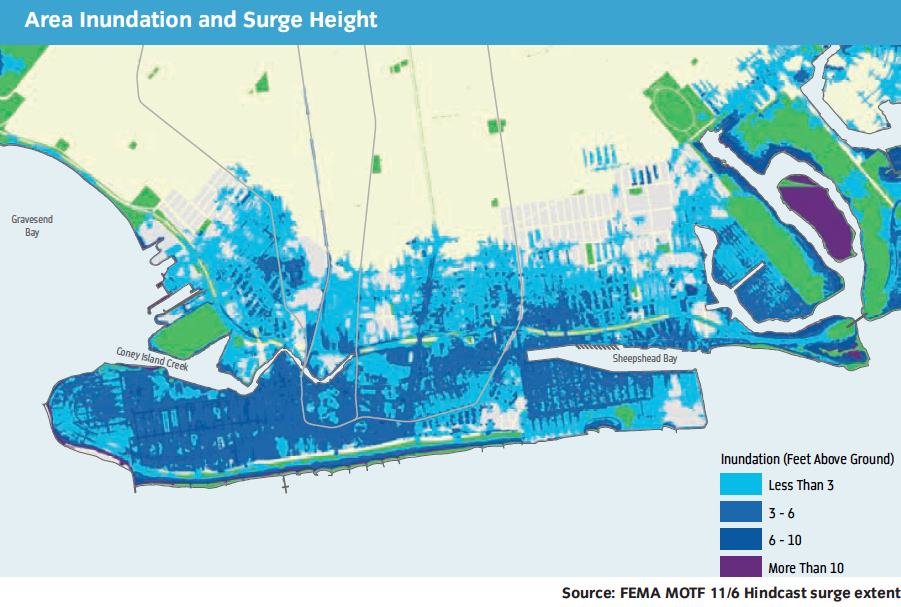
Large scale operations suffered from water damage and power loss. The New York Aquarium had an estimated $65 million in damage in their exhibits. Coney Island Hospital, as well as many other nursing homes, adult care residences, and outpatient facilities, lost power and were forced to evacuate. At the Coney Island Yards, service was down for 9 days due to damage to track switches. And at the Coney Island Waste Water Treatment Plant workers “labored heroically” to get the plant back online quickly in order to minimize discharge of untreated wastewater.
In the future, the updated 100 year floodplain maps now include almost all of the areas of Southern Brooklyn that were once marshland. Sensitive facilities such as Coney Island Hospital and Coney Island yards are now in the floodplain. As storms occur more often and more and more buildings are threatened by the storm surge, it will become more challenging to restore coastal protections between extreme weather events.
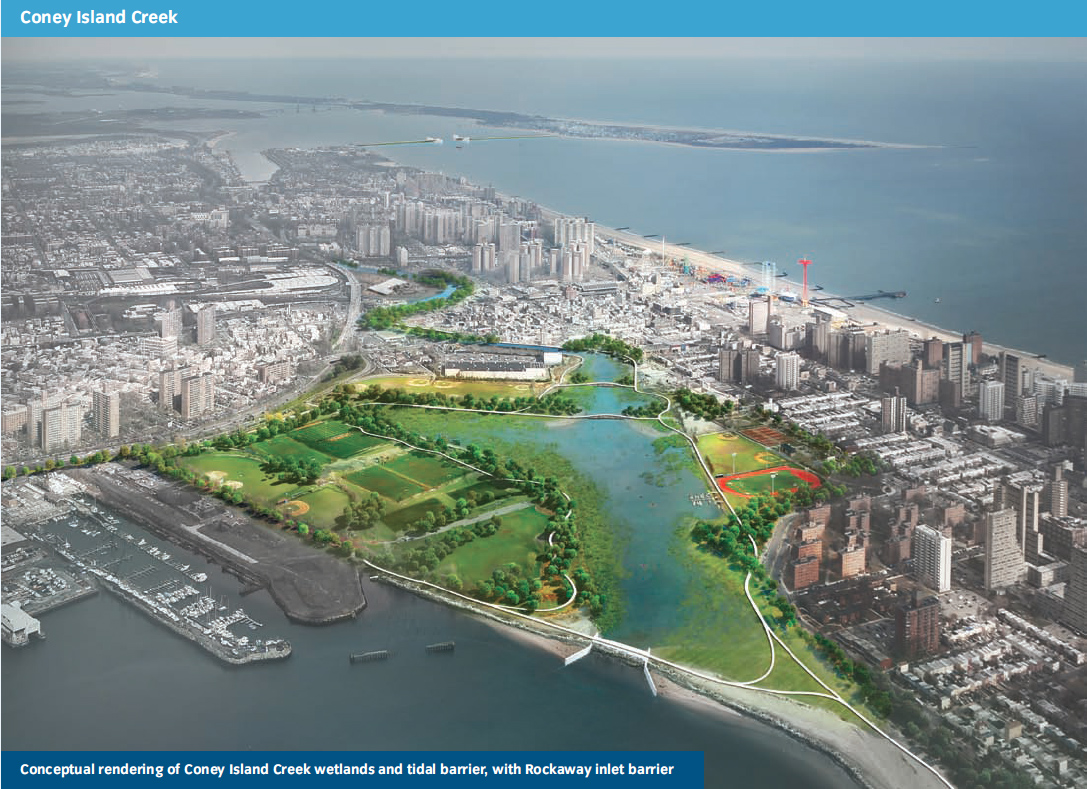
Two initiatives highlighted by City Atlas are below, followed by a summary of the full set for Southern Brooklyn:
For the Atlantic Coast of Southern Brooklyn, coastal protection largely means continuing Army Corps of Engineers beach replenishment, but a new concept to guard against flooding from Coney Island Creek is to create a wetland park along the course of the waterway. Moving the landscape back to coastal wetland shows how the city is learning that restoring natural coastlines may ultimately provide the most resilient urban feature, in a future of higher sea level and potentially bigger storms.
Renovation as a way to try new building technology is shown in an initiative that cites CUNY’s Building Performance Lab. The lab will launch “a study and pilot program in Southern Brooklyn to place backup renewable energy systems and on-site renewable energy generation at high-rise residential buildings, in part to aid resiliency. The City will provide technical assistance, as needed, for CUNY’s study and the eventual launch. Such technologies may provide building-specific solutions for energy resiliency and help ease pressures on the grid in times of peak demand, while also producing cost savings for the relevant consumers.”
And the full set of summarized initiatives follow, with some already underway:
Coastal protection
Coastal Protection Initiative 1: Support beach nourishment from Corbin Place to West 37th Street, replacing 1 million cubic yards of sand lost during Sandy
Coastal Protection Initiative 4: Raise edge elevations with revetments along Coney Island Creek to prevent “backdoor” flooding.
Coastal Protection Initiative 6: Raise bulkheads across the city in low-lying areas.
Coastal Protection Initiative 7: Complete bulkhead repairs along the Belt Parkway, including at 14th ave, 17th ave, and 95th street.
Coastal Protection Initiative 16: Support completion of phase 2 of beach nourishment project at Plumb Beach.
Coastal Protection Initiative 18: Support construction of groins in the Sea Gate Neighborhood.
Coastal Protection\Southern Brooklyn Initiative 1: The Sea Gate Neighborhood is particularly vulnerable to wave risks because of the neighborhood’s decision not to participate in the USACE’s mid-1990s replenishment project. They would have only received federal funding if they had allowed public access to their beach. After seeing the dramatic damage of Sandy, the Sea Gate Association will likely be required to provide public access to the community’s beaches in order to obtain federal funding.
Coastal Protection\Southern Brooklyn Initiative 2: Although beach nourishment and reshaping is critical, the city will also work with the USACE to develop additional measures such as a structured dune system, seasonal installation of “snow-fencing,” and potential reinforcement or extension of existing groins.
Coastal Protection\Southern Brooklyn Initiative 3: Because of an extensive ownership dispute, the historic esplanade at Manhattan beach has not been repaired since a 1993 nor’easter. The city will plan options for reinforcing the Manhattan beach waterfront from Corbin Place to Kingsborough Community College. The city will also encourage private waterfront property owners to engage with the USACE plans.
Coastal protection\Southern Brooklyn Initiative 4: Develop a local storm surge barrier to be constructed across Rockaway Inlet approximately between Manhattan Beach in Brooklyn and Breezy Point in Queens. Environmental impact studies will have to take place. Also consider alternative approaches such as the use of the elevated Belt Parkway as a levee, permanent levees along the perimeter of the bay, and the “shallowing” of Jamaica Bay.
Coastal Protection\Southern Brooklyn Initiative 5: Consider rethinking of Coney Island Creek wetlands with edge strengthening and edge softening measures with a potential dam across the creek to control tidal surge and improve water quality. Although these changes would impeded future navigation of the creek, this environmental redevelopment would present an unprecedented opportunity to reduce future flood risks for the entire Coney Island community—including sensitive infrastructure sites.
Buildings
Buildings Initiative 1: Improve regulations for flood resiliency for existing buildings and new construction, including 4,500 units in Southern Brooklyn.
Buildings Initiative 2: Repair buildings damaged by Sandy, including 380 residential buildings, comprising 1,500 units, in Southern Brooklyn
Buildings Initiative 3: In SB neighborhoods including Gerrtisen Beach, DCP will explore zoning and land use changes that could encourage residents to make improvements to existing homes and build more resiliently in the future.
Buildings Initiative 4: Create a competition that will offer prizes to developers who design and develop high-quality housing prototypes that are cost effective, conform to zoning requirements, and are, most importantly, highly resilient.
Buildings Initiative 5: The city will buy out homes rendered extremely vulnerable by Sandy—no areas identified in SB
Buildings Initiative 6: Amend building code so that buildings city wide can meet enhanced standards for wind resiliency.
Buildings Initiative 7: The city will launch a $1.2 billion program that incentivizes resiliency investments in existing buildings. The city will also mandate that large buildings undertake certain flood resiliency investments by 2030. In SB, nearly 45,000 units/55 million square feet of built space would be made less vulnerable.
Buildings Initiative 8: City will establish Community Design Centers in neighborhoods across the city that will provide information about resiliency investments.
Buildings Initiative 9: Repair public housing developments across the city that were damaged by Sandy and incorporate new resiliency measures. In SB, 40 buildings with over 4,000 units will be repaired.
Buildings Initiative 10: Launch $10 million program providing incentives to owners of industrial buildings to encourage resiliency investments.
Buildings Initiative 11: Launch $40 million Resiliency Technologies Competition to encourage the development, deployment, and testing of new resilient building technologies and systems.
Buildings Initiative 12: Clarify regulations relating to retrofit of landmarked structures in floodplain—7 in SB.
Buildings Initiative 13: Expand existing DOB façade inspection safety programs to include rooftop structures and equipment.
Buildings\Southern Brooklyn Initiative 6: In SB there are many public housing buildings with ground floor units that are extremely vulnerable to flooding. 1) Build new resilient units to replace at risk units and move current tenants. 2) Study how these ground floor units could be repurposed, ie for commercial or community services.
Insurance
Insurance Initiatives 1, 4, 6: Less than 17 percent of residential properties in South Brooklyn actually had policies in force during Sandy. These initiatives call on FEMA to complete study of flood insurance affordability by creating more flexible pricing options, including premium credits for mitigation measures other than elevation and creating a higher deductible.
Critical Infrastructure
Critical Infrastructure\Utilities Initiatives 5, 6, 7: Approximately 160,000 lost power in Southern Brooklyn during Sandy. Examine which assets are most critical to the greatest number of people and make the necessary resiliency investments to energy transmission. This includes natural gas and steam providers. The hope is to speed up service restoration. (2013)
Critical Infrastructure\Utilities Initiative 21: Continue efforts to achieve the PlaNYC goal of installing 800 megawatts of Distributed Generation including microgrids.
Critical Infrastructure\Utilities\Southern Brooklyn Initiative 7: Launch a study and pilot program to place backup renewable energy generation systems at high-rise residential buildings
Critical Infrastructure\Utilities\Southern Brooklyn Initiative 8: Explore changes to Construction codes and other regulations to ensure resiliency measures are in place at private cogeneration plants in Southern Brooklyn.
Critical Infrastructure\Liquid Fuels 1, 4, 5, 8, 9: improve resiliency of gas stations, ensure there are back up plans to power New York City’s fleet of emergency vehicles, and create a collection of shared emergency supplies (ie generators) that can be immediately deployed.
Telecommunications Initiative 1+2: Require Telecommunications providers to become resilient through the creation of the Planning and Resiliency Office that will have the power to enforce resiliency standards for telecommunications providers through New York City’s contract renewal process.
Healthcare
Healthcare Initiatives 2, 3, 4, 5, 6, 7, 8, 9: Require retrofitting of current hospitals, nursing homes, adult care facilities, and mental health clinics on floodplains and ensure that new construction is resilient.
Healthcare Initiatives 10, 11: Improve the power and telecommunications resiliency of pharmacies to ensure that patients always can get access to their prescriptions.
Healthcare Initiative 12: Encourage electronic health record keeping to ensure that no patient’s health records get lost or damaged in a natural emergency.
Healthcare\Southern Brooklyn Initiative 7: Sandy destroyed Coney Island Hospital’s outpatient facility, the Ida G. Isreal Clinic. Instead of rebuilding in the current, vulnerable location, the city will locate a new location and build an interim facility ASAP.
Transportation
Transportation Initiative 1: Reconstruct damaged streets, five linear miles of which are in Southern Brooklyn
Transportation Initiative 3: Raise traffic signals and controllers at over 500 intersections throughout the city so that they are above flood heights.
Transportation Initiative 8: Encourage non-city agencies to implement resiliency strategies
Transportation Initiative 9: When the subway is out of service, there is not capacity in the rest of the transportation network to carry the increased volume of travelers–develop plans for transportation that can function in the event of subway outages.
Transportation Initiative 10: Plan for quickest recovery of transportation systems as possible
Transportation Initiative 16: Expand New York City’s High Capacity Bus Service (SBS)
Transportation Initiative\Southern Brooklyn Initiative 8: Call on the USACE to develop options for reinforcing and strengthening existing edge protections along the Belt Parkway beyond the immediate repairs underway.
Parks
Parks Initiative 1: Restore beaches damaged by Hurricane Sandy, create a contigency plan to quickly restore beaches after future extreme weather events, and create new elevated beach infrastructure including lifeguard stations and bathrooms.
Parks Initiative 2: Reinforce and redesign shoreline parks, including new bulkheads. Marine Park, Manhattan Beach, Calvert Vaux Park, Kaiser Park, will be targeted in Southern Brooklyn.
Parks Initiative 4: Expand the Greenstreets system; construct and maintain 1,600 Greenstreets at a high density, with priority going to the area surrounding Jamaica Bay.
Parks Initiative 11: Improve health and resiliency of urban forest by 1) increasing size of forest management crews, 2) identifying locations to expand tree beds, and 3) modifying tree inspection schedule to prioritize trees in areas vulnerable to extreme weather events.
Parks\Southern Brooklyn Initiative 9: Restore recreational infrastructure along Southern Brooklyn beaches including facilities (comfort stations, lifeguard stations, and administrative buildings) at Plumb Beach, Manhattan Beach, Brighton Beach, and Coney Island.
Healthcare
Water and Wastewater Initiative 1, 2, 3: Increase resiliency of water and wastewater systems
Water and Wastewater Initiative 8: Through expansion of parks and Green Streets, reduce stormwater runoff in order to reduce combined sewer overflows
Water and Wastewater\Southern Brooklyn Initiative 10: In anticipation of new development on Coney Island, expand drainage infrastructure–$137 million in planned upgrades including enlarging pipes and outfalls.
Water and Wastewater\Southern Brooklyn Initiative 11: Even though Sea Gate is a private community, their sewers tie into the City’s and so the City will help them repair Sandy damaged infrastructure.
Disaster Preparedness
Community Disaster Preparedness Initiative 1: Taking an example community, analyze the strengths and weaknesses in order to better address a community’s issues.
Community Disaster Preparedness Initiative 2: Expand emergency response teams to better organize communities for natural disasters.
Economic Recovery
Economic Recovery Initiative 1: Launch $25 million sales tax waiver program to help businesses get back on their feet.
Economic Recovery Initiative 2: Launch a system for public grants for projects that spur economic activity and match public funding with private capital.
Economic Recovery Initiative 3+4: Support small businesses and nonprofits along certain corridors with discounts. In Southern Brooklyn, these corridors could include Brighton Beach Ave, Coney Island, Emmons Ave, or Gerritsen Ave.
Economic Recovery Initiative 5: Continue to support the FRESH program–a series of zoning and financial incentives for supermarkets to move to neighborhoods underserved by grocery retail.
Economic Recovery Initiative 6: Reassess commercial property values citywide to reflect post-Hurricane Sandy market values, effectively lowering taxes.
Economic Recovery Initiative\Southern Brooklyn Initiative 12: Work with the Brooklyn Chamber of Commerce to help Sheepshead Bay businesses organize and improve.
Economic Recovery Initiative\Southern Brooklyn Initiative 13: Support area recovery through rebuilding and expansion of entertainment district. This includes the construction of new amusements, new amphitheater and arts center, and expansion of the NY aquarium.
Economic Recovery Initiative\Southern Brookyln Initiative 14: Identify waterfront redevelopment and edge improvement opportunities along Coney Island Creek.
Economic Recovery Initiative\Southern Brooklyn Initiative 17: Continue with planned investments in Southern Brooklyn Parks and developments.